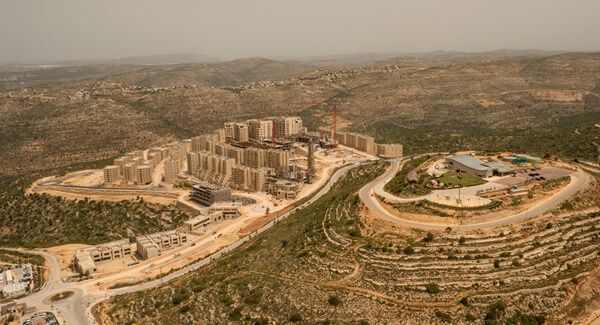The Irish Times has published a series of three stories ostensibly taking a Palestinian perspective on current issues. Biased and skewed reporting is clearly evident as is the norm for the Irish Times.
In the first article, “Palestinians must use politics to end ‘apartheid regime’,” journalist Michael Jansen conducts an interview with “Israeli peace activist Jeff Halper” who is also described as “a veteran critic of Israeli police.”
What Jansen fails to reveal is that Halper is anything but a “peace activist.” Indeed Halper’s criticism of Israel goes far beyond that of its police force. Halper is a radical anti-Israel activist and the director of the Israeli Committee Against House Demolitions (ICHAD).

As NGO Monitor notes:
- ICAHD’s rhetoric includes accusations of “ethnic cleansing,” “genocide,” “collective punishment,” and “apartheid.”
- Active in promoting the BDS (boycotts, divestments and sanctions) campaign against Israel.
- Explicitly advocates for the end of the state of Israel as the nation state of the Jewish people, stating that “the only option for resolving the conflict [is] a one-state solution.”
In his comments to the Irish Times, Halper claims:
The Israeli army is everywhere. Squads posing as Palestinians enter Palestinian towns and villages at will and arrest and shoot Palestinians.
In Halper’s mind, Israeli soldiers simply shoot Palestinians. As Halper well knows, the IDF has strict rules of engagement and opening fire on Palestinians, be they armed or otherwise, is not taken lightly.
But then, this isn’t the first time that Michael Jansen has given an unchallenged platform for Halper to incite against Israel.
Jansen continues her story, interviewing PA foreign minister Nabil Shaath, who advocates for boycott, divestment and sanctions (BDS) against Israel and describes the Palestinian campaign as an “anti-apartheid struggle.” It’s all too easy to throw unverified figures around such as Shaath’s claim that Israel has taken over 92% of the West Bank’s water.
In fact, as StandWithUs makes clear, Israel uses the same aquifers for its water today that it used before 1967, when its administration of the West Bank began. The water in the aquifiers naturally flows seawards, into Israel. Israeli settlements are connected to Israel’s national water system and do not use the Palestinian Authority’s water system. Palestinian fresh water consumption grew over 300 percent between 1967 and 2008.
Despite the scarcity of water, Israel agreed in the Oslo Accords to annually give 31 million cubic meters (mcm) of its own water to West Bank Palestinians to supplement their water resources. In fact, Israel has given progressively more each year. In 2008, Israel gave 40 percent more than agreed upon: 51.8 mcm.
* * *

The water issue is repeated in Jansen’s second article, “Israeli expansion forcing Palestinians into ancient city of Jericho“:
The settlers consume 6.6 times more water than the Palestinians, who are 8-9 times more numerous. “Palestinians are not allowed to sink new artesian wells,” he [Jericho district governor Majed Fityani] says. “They can only use the 200 present during Jordanian rule before 1967. Now there are 67 functioning and their salt content is high. People in the valley are planting palm trees due to salt; vegetables [formerly a main cash crop] are at a minimum.”
Referring to a study published by the Begin-Sadat Center for Strategic Studies, David Weinberg notes that Professor Haim Girtzman:
demonstrates that the current division of natural fresh water resources between Israel and the Palestinians is fair. Israel’s population stands at 7.2 million, five times the actual West Bank Palestinian population of 1.4 million. Proportionately, Israel controls 1,200 m.c.m. of the available natural fresh water, and the PA 220 m.c.m. In per capita terms, this works out to about 160 metric cubes of water per person per annum in both Israel and the PA.
As for settler water use, well, Israel sends into the West Bank for Palestinian usage far more water than settler communities use.
Moreover, the study shows how the Palestinians have illegally drilled over 250 unauthorized wells, polluting their own (and Israel’s) water supply as well as refusing to develop sewage treatment plants or manage existing water infrastructure properly.
You can see more here on how the Palestinians politicize the water issue to bash Israel.
But it isn’t only Palestinian spokespeople skewing the truth. Michael Jansen herself comes up with this:
Israel’s 700km-long grey West Bank wall snakes its way across the West Bank close to Jerusalem on the summit of mountain range.
Considering Israel’s security barrier is over 90% chain-link fence, Jansen’s description of a contiguous wall is simply false. Not only that, but the barrier’s intended route has not even been completed as of 2015.
This isn’t the only falsehood in the article, which also claims, in reference to Palestinian residential building:
In Jericho, Israel charges huge fees for building permits, which take years to obtain and require lawyers’ fees, and then it levies heavy taxes once buildings are completed.
Israel is indeed responsible for issuing building permits in Area C of the West Bank, which is under full Israeli security and administrative control. Jericho, however, is in Area A, which is under the full administrative control of the Palestinian Authority. Israel simply does not issue building permits for Palestinian homes or other structures within major Palestinian cities in Area A such as Jericho.
And how can Jansen defend this outright lie?
Israel’s 2010-2020 Master Plan aims to ensure a 60:40 ratio of Jewish to Palestinian residents of Jerusalem, annexed by Israel in 1967, through administrative deportation to Jericho, other West Bank cities and abroad.
The Master Plan is nothing sinister as Jansen contends. Instead, it deals with the long-term planning for all residents of Jerusalem, both Jewish and Arab. It plans for, among a whole host of urban planning, dealing with illegal building in the eastern side of the city as well as approving construction of thousands of residential units for Palestinian residents of Jerusalem.
While this may entail some relocation within the Jerusalem municipal area, there is no plan to administratively deport Palestinians to West Bank cities or abroad.
* * *

Michael Jansen’s third article in her series, “Palestinian Hills are alive with the sound of construction,” begins:
Rawabi is the first new town to be built by Palestinians on Palestinian soil for as long as anyone can remember. Doubting Palestinians, Israelis opposed to the project, and sceptical observers all see it as an expensive aberration on the tortured landscape of the Israeli-occupied West Bank.
Palestinians call Rawabi a $1 billion white elephant and an attempt to “normalise” the Israeli occupation because Israel had to grant permission for its creation and construction, and Israeli firms provided raw materials.
Rawabi is possibly one of the most positive developments for the Palestinians going back many years. Despite this, Jansen clearly cannot conceive that Palestinians can be anything but perpetual victims of Israel. She therefore goes out of her way to knock down Rawabi before it has even been completed, attempting to portray the nascent city as an illegitimate and negative project.
For Jansen, anything potentially positive in Palestinian society takes away from the narrative of Palestinian suffering at the hands of Israel. This is the narrative that is consistent throughout her three-part series, a narrative dominated by support for BDS, the anti-normalization of Israeli-Palestinian relations and outright lies and distortions.
[sc:graybox ]You can send your considered comments to the Irish Times – [email protected]. See the Irish Times’ guidelines for writing letters.
Featured image: CC BY-SA Victor Grigas via Wikimedia Commons; CC BY Elisa via flickr; with modifications CC BY-SA by HonestReporting


